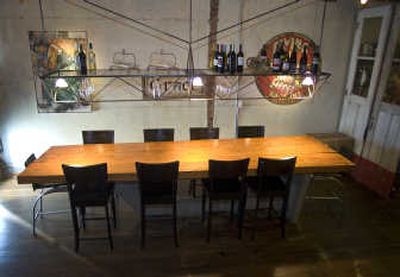Living in small space takes big ideas

Bo Cooke’s toolbox looks like your typical, rugged Craftsman chest. Sleek and black, with tread-plated steel facing, it is a hallmark of masculine organization. But you won’t find any hammers or wrenches inside.
Sitting on Cooke’s kitchen counter in his Spokane loft, the toolbox’s shallow, rubber-lined drawers instead house spatulas, spoons and other cooking implements laid out like surgical tools on a sterile tray.
Nearby, a larger tool chest on casters serves as a combination kitchen island and mobile pantry, allowing Cooke a quick, birds-eye view of the cabinet’s contents.
“I can see that I have two cans of that and one can of that,” he says, staring down into an open drawer. The tool chest – a Gladiator by Whirlpool – even comes with a coated maple butcher-block surface, though Cooke uses his own raw wood cutting board atop the moveable island.
While such heavy-duty storage solutions are typically found in a well-organized garage, these repurposed tool kits are ideal for small living spaces as well – in this case, Cooke’s apartment in a beautifully refurbished building in downtown’s east end. Although he and his fiancée, Holly Elmer, are currently laying the groundwork for a Frank Lloyd Wright-style home in the South Perry Street area, after nine years of loft-living, Cooke has learned a thing or two about storage in small places. Over the years, he has worked with building owner Dan Spalding, and other friends, to perfect his living quarters.
“I just know what I like, so it’s worked out that way,” he says.
Other kitchen space-savers include an antique skylight that stores hanging skillets and pans while allowing natural light to illuminate the kitchen from a more contemporary skylight in the ceiling above.
Across the room a vintage window that once looked out to an internal airshaft now houses Cook’s custom spice rack – two chrome bike wheel rims that revolve, lazy-Susan style, offering easy access to spices and condiments. Another creative use of space is Cooke’s custom steel garbage can that occupies what would be an otherwise unusable recess left by one of the building’s structural pillars. The garbage can, designed by local metal artist Tim Biggs, stands waist-high, with a two-tone bowed steel plate exterior that is almost flush with the surrounding lower cabinets. The artful receptacle opens with a tug on its brushed-chrome handle, and incorporates a clever self-closing feature that utilizes an overhead pulley and weight.
In the dining area, Cooke recently installed a combination wine-rack, glass holder and chandelier, suspended over a custom farm-style table made of wide wooden beams. Antique wired glass plates provide storage for guests’ wine bottles while allowing light to shine through from above. Clear wine goblets and other glasses dangle upside down, reflecting light from three glass pendants that descend from a track high above, penetrating the open space afforded by the rack’s unique bridge-truss design.
“I didn’t want it to be too heavy,” Cooke explains, though he says the piece is substantial enough to add an intimacy to the dining area that it lacked when lit only by strands of track lights hugging the rafters.
“Just by visually dropping the ceiling, the amplitude of conversations has dropped, and people move forward (to talk). It’s kind of a psychological thing.”